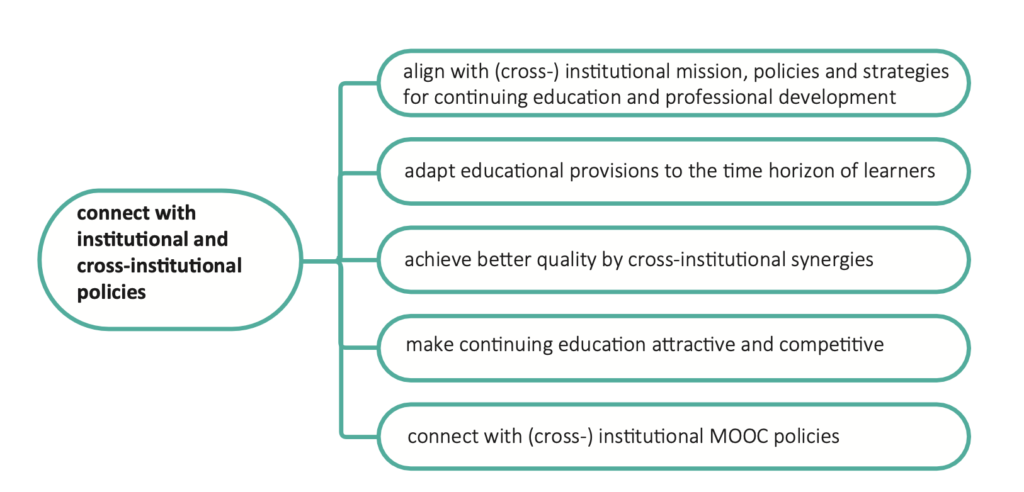
lorem
| A micro-credential course should connect with institutional and cross-institutional policies: |
|
|
|
|
|
Align with the (cross-)institutional mission, policies and strategies for continuing education and professional development
European higher education is evolving into three areas of education: mainstream education, continuing education and open education (OER, MOOCs). In the perspective of the transformation agenda for higher education, universities are becoming more interwoven with the knowledge-intensive sectors of society, responding to the needs of the economy and society as a whole.
Some leading universities have already developed comprehensive policies for continuing education and professional development in line with their mission. They have built a framework for continuing education and professional development, for example an extension school or continuing education centre. They have developed an institutional qualification structure for awarding certificates for micro-credential courses and programmes. These are closely linked to research and innovation and mainstream education in their institution.
Nevertheless, it remains a challenge for all universities to create facilities for adult learners.
To make continuing education and professional development more relevant and engaging, universities seek collaboration with stakeholders such as employers, professional organi- zations or business sectors.This will lead to the co-creation of courses and microlearning units in a variety of ways such as needs analysis, the definition of knowledge and skills to be achieved; the co-creation of content; the design of learning activities; internships; or the endorsement of micro-credential qualifications.
Adapt educational provisions for continuing education and professional development to the time horizon of learners at work
Universities are aware that continuing education and professional development must adapt to the time horizon of learners through new forms of education such as micro-credential courses and programmes. These new provisions can be recognized as stackable modules for broader degree programmes.
This approach creates new opportunities for continuing education and professional development. It is now supported by the European Commission, which has proposed a Recommendation to the Council of Ministers to establish a framework for micro-credentials (European Commission, 2021b).
Thus, it becomes a new priority for national governments and higher education institutions. Frontrunner universities will help determine this development.
Achieve better quality through cross-institutional synergies
By organizing micro-credential courses and programmes, universities achieve better quality through institutional synergies. They make their best content available within the partnership to respond to real-world needs in society.
This collaboration builds on and promotes close interaction with research and innovation departments in the partnership. Through these synergies, they enhance both the research and professional orientation of micro-credentials.
Micro-credential courses and programmes are also an asset for pedagogical innovation that enables institutions to reach learners across Europe, create an international experience for them and apply new ways of delivery, using methods of blended, synchronous hybrid and online distance learning.
Make continuing education attractive and competitive at national, European and global level
Leading universities can offer micro-credential courses and programmes to make continuing education more attractive and competitive at national, European and global levels. Digital delivery methods enable them to scale up participation in micro-credentials and improve quality in content and pedagogy.
In this way they provide institutional, national, European and international added value.
Connect with (cross-)institutional MOOC policies
Universities can link policies for continuing education and the development of micro-credentials to their policies regarding MOOC offerings.
Many universities in Europe develop MOOCS, which are published either on a MOOC platform or on their own website. On European platforms alone, about 400 universities are active with 3500 MOOCs, followed by 25 million learners. This is open education on a large scale.
MOOC platforms provide services to universities for the design, development and delivery of MOOCs, while the academic responsibility and ownership remains in the hands of the university. MOOCs are free. A fee is due for assessment and awarding of credits by the university.
Some platforms develop MOOC pathways, consisting of a coherent set of MOOCs, in several cases in collaboration or co-design with the labour market.
European MOOC platforms are offering MOOCs in mainly one language:
Futurelearn (UK, English)
France Université Numérique – FUNMOOC (FR, French)
Miriadax (SP, Spanish)
OpenEdu (IT, Italian)
NAU (PT, Portuguese)
iMooX (AU, German)
AI Campus (GE, German)
The European MOOC Consortium created the Common Micro-credential Framework for digital courses with a total learning volume of 4-6 ECTS at levels 5, 6, 7 or 8 of the European Qualification Framework (European MOOC Consortium, 2018).
European universities can publish MOOCs on the OpenupEd portal for global exposure (OpenupEd, 2013).
MOOCs, MOOC pathways and micro-credentials that are suitable for the labor market can also be published on the MOOCs4you portal (EADTU, 2022b).
next chapter: Share a joint vision on the micro-credential course
previous chapter: The design of a joint micro-credential course
and microlearning units: overview of successive steps
back to overview: Models and guidelines for the design and development of
joint micro-credential courses and microlearning units in higher education
